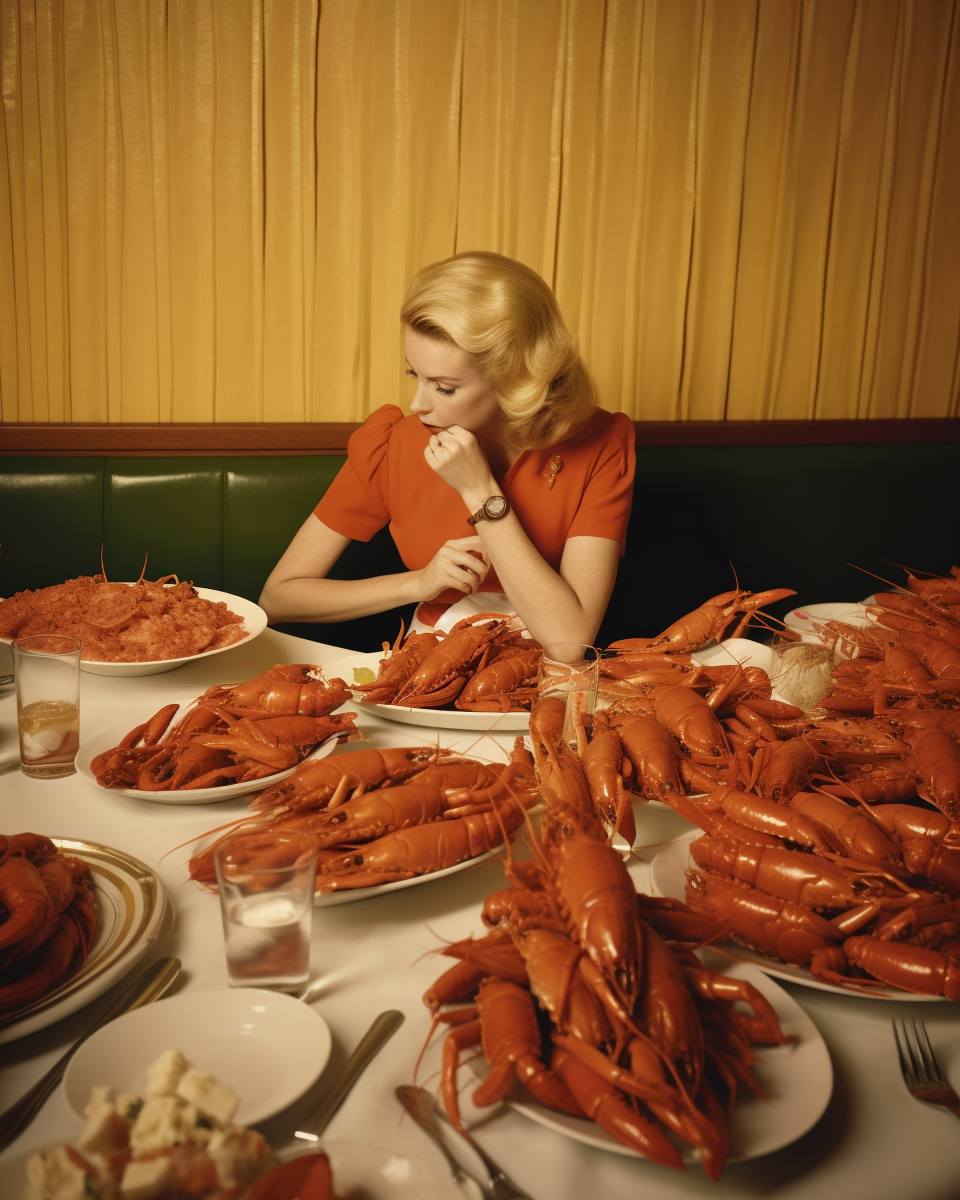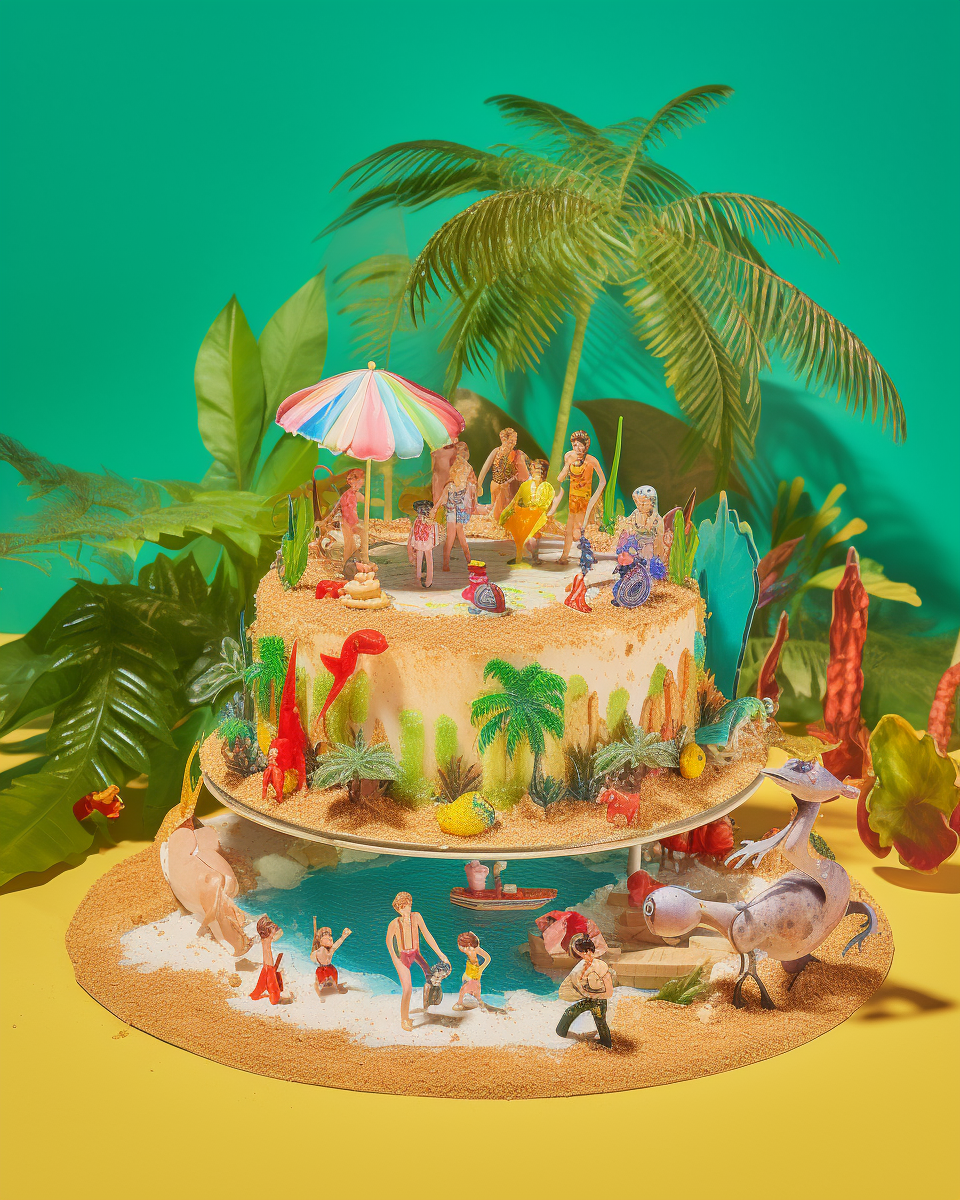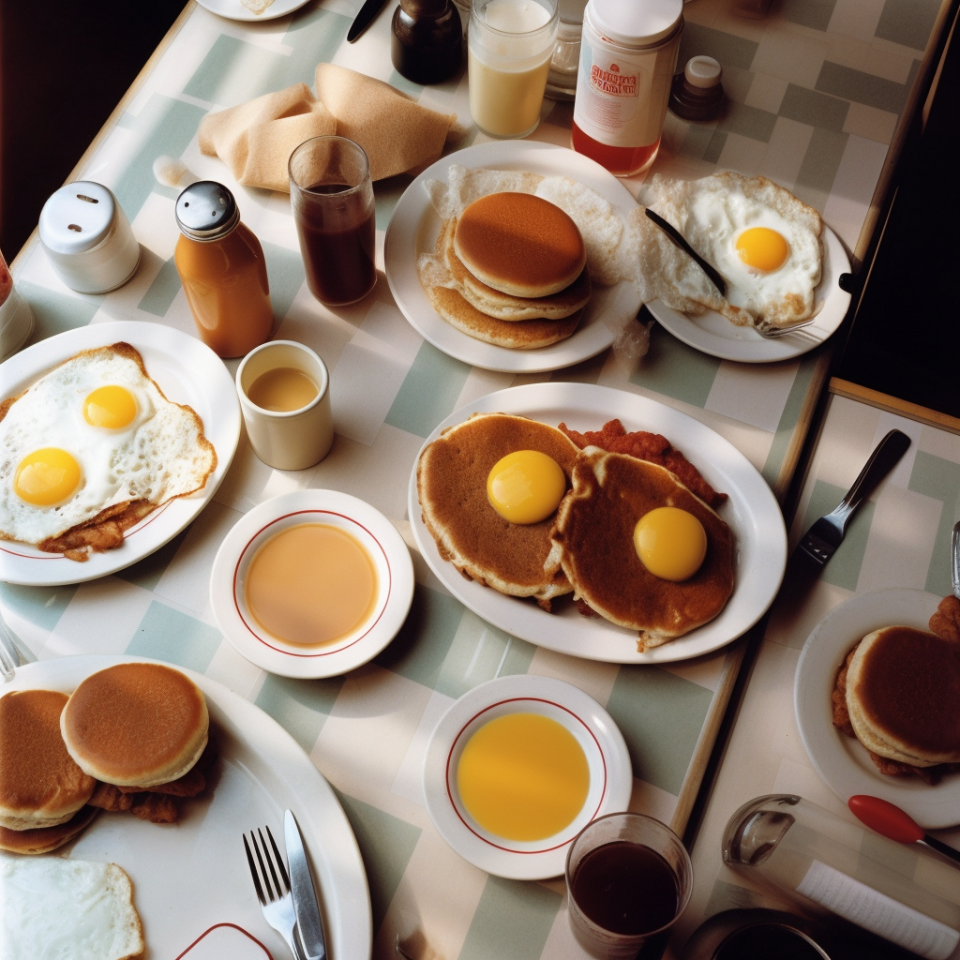Scary and fascinating: These Michigan photographers are using A.I. to boost creativity
In a recent photo series by commercial photographers Michelle Gerard and Jenna Belevender, five subjects are pictured with mounds of whole lobsters before them.
In one shot, a slender, 1950s-era woman is seated solo at a retro leather diner banquette. Her wavy hair is golden, perfectly coiffed with no strand out of place, and her rouged lips and red-orange dress match the dozens of lobsters plated at her table.
In another, an elderly man with frosty white hair and leathery skin leans back in an office chair with a mangle of lobsters piled on top of stained newspapers.
The series is curious. The lobsters are healthy and large, vibrant in color and abundant in each shot, and yet the glimmer of gluttony that twinkles the eye of anyone confronted with even just a single lobster is missing from each subject. The side dishes are unintelligible — there might be a platter of rice, maybe thick squares of butter laid bare on a table. Is that a breakfast sausage link? Hunks of marinated feta cheese? If you look closely at the shot of the gentleman, the corkboard behind him is tacked with papers with writing in another language, a language likely foreign to all of humanity.

The series is titled the “AI Lobster Study,” and it’s one of the photography duo’s first experimentations with artificial intelligence. The subjects are computer-generated, the sides are likely a glitch of the technology and that indecipherable language on the corkboard is possibly the dialect of the A.I. software. The lobsters are interpretations of the pair’s “Prison Lobster” shot from a recent “Weird Food History” series produced earlier this year.
“It’s sad and scary and it’s fascinating,” Gerard wrote of her venture into the world of A.I. in food photography in the lobster series description.
More: Atwater Brewery unveils new craft beer brewed using artificial intelligence
More: AI generated images of a 'typical' home in each state, 30 biggest US cities
The prompt to toy with ChatGPT and Midjourney, the chatbot and generative A.I. program that Gerard and Belevender utilize most often, was the result of the duo’s interest in developing new skills and a strong belief that adapting to a rapidly changing industry due to technology is the surest way to stay in business.
“We had a couple of jobs come through and they decided to use A.I. instead of us,” Gerard explained.
The use of A.I. allows brands and business owners to produce content quickly and affordably, potentially cutting the demand for human collaboration. This instinct feels familiar for Gerard and Belevender, who witnessed the transition to digital photography, but the couple sticks to the belief that true creativity cannot be replaced.
“Our industry is constantly changing. People need content every day now. If they’re posting on social media, it’s about quantity over quality, so we have to keep up with new technology. For us, it’s just about sticking to our style and to what we love and working with the people who appreciate what we do. That’s really all we can do.”
On top of concerns of job security among photographers like Gerard and Belevender, there are also concerns that computer-generated imagery may lead to misinformation.
More: ChatGPT has 4 keys for the Detroit Lions to win the Super Bowl this season
More: Mitch Albom: ChatGPT is smart, fast and easy — all the reasons you should be wary
“There are a lot of discussions and laws being worked on as we speak about A.I. images needing to be clearly labeled as such,” Gerard said. “There are legal and ethical guidelines about A.I. that are still evolving alongside the tech, but essentially, the end goal is for A.I. to be used responsibly and transparently.”

Regarding restaurant and hospitality photography, there are obvious limitations to A.I.: “At the end of the day, people want to see real images of the food they're going to eat, not computer-generated ones,” Gerard said.
Still, the team sees the value in A.I. for creatives operating small businesses like theirs. “Right now, I see food photography and A.I. merging to dream up ideas that aren't doable or practical in the real world. It's all about creating art."
By feeding the program prompts for specific scenes, lighting preferences, aspect ratios and photography styles, what results are A.I.-generated images that then may inspire live sets for Gerard and Belevender to bring to life in their Hamtramck studio. Rather than drawing inspiration from Pinterest, magazines or visuals published elsewhere by other creatives, programs like Midjourney and ChatGPT, Gerard and Belevender said, allow them to storyboard their wildest ideas.
“The big problem for shoots that we were creating was when I was trying to find reference imagery for say, a Barbie Dreamhouse bar — I couldn't find anybody who had done anything like it,” Gerard said. “That happens a lot with our work because our ideas can be really weird. Midjourney has been a great tool in being able to visualize these ideas and take them further from there.”
Next month, Gerard and Belevender’s “Convergent Diner” series commissioned by Morgenmete Journal will publish in the indie food magazine focused on breakfast. The trippy images are Gerard and Belevender’s real-life recreation of the bizarre inaccuracies of A.I.-generated images. There are hashbrowns served with whipped cream and a handful of cherries, pancakes topped with egg yolks in place of butter and restaurant checks written in that foreign language of the alternate universe.
Gerard and Belevender said the process for the “Convergent Diner” series became unexpectedly collaborative with ChatGPT.

“I shared my concept of transforming the diner into an otherworldly portal, and ChatGPT began offering scientific theories and sci-fi themes to enhance my idea,” Gerard said, adding that she’d type specific questions in the chatbot and in return, images that were surprisingly inspirational would populate. “The A.I. evolved from being a simple tool to a collaborator. It wasn't just executing tasks; it was contributing to the creative process, challenging my ideas, and pushing me to think outside the box because that’s what I asked it to do.”
A.I. programs also allow photographers, food stylists and set designers like Gerard and Belevender to test concepts without spending exorbitant fees to produce sets and trial shoots that don’t pan out as planned.
“As creatives, we often have more ideas than we have time and money to make them all happen, but with a tool like Midjourney, we can explore ideas just by typing a few words,” Gerard said. “What’s great about A.I. is that it’s all about trial and error. I can type out an idea, see what it comes up with and then tweak my concepts. This back and forth allows me to rapidly evolve ideas, which is especially helpful in the early brainstorming stages of a project.”
Gerard adds other helpful uses for A.I., such as generating scenic backgrounds that can then be printed and used as backdrops and other practical elements for live sets. Though some may choose to create imagery solely in the software, she’s energized by the idea of bringing the visuals to life whenever possible.
“Looking ahead, I’ve got big plans and dream projects in mind,” Gerard said. “Exploring the possibilities of A.I. in different creative domains and pushing the boundaries of what's achievable is something that truly excites me. I’m looking at it now as a tool to help me create large scale sets, and design world building elements to create something truly immersive. The possibilities seem endless and I’m here for it.”
Follow @gerardbelevender on Instagram for photos from the “Lobster Study,” the “Convergent Diner” series and more.
This article originally appeared on Detroit Free Press: How food photographers are using artificial intelligence software

